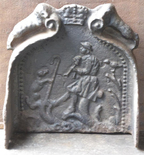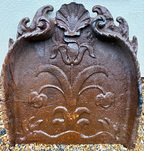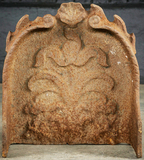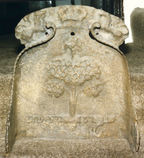-
1128
Description: Quasi-arched shape with forward-facing 'wings', which splay outwards towards the base; the 'wings' curve to follow the shape of the main panel but curl outwards at the top; central panel with pictorial image of, to the right, a shepherd holding a musical pipe, his right foot upon a log, upon which a dog, to the left, sits holding the shepherd's crook; top centre, a crown, on either side of which, on the curled upper parts of the 'wings', is an inward facing sheep.
Notes: Nothing is known about the sources of free-standing firebacks or what prompted their production. Their form is similar but the predominant use of horticultural or arboreal decorative themes, which suggests production within a limited time frame, has in this instance been replaced with a humorous scene. Only a very small number of such castings are known. Depth 210mm
- Decoration tags:
- free-standing (shape)
- none (edging)
- whole carved pattern
- heraldic
- pictorial
- animals
- humans
- plants
- objects
Manufactured: in the late-17th to early-18th century in England.
Current location: not known.
- Attached to series:
- Free-standing firebacks
-
1268
Description: Quasi-arched shape with forward-facing 'wings', which splay outwards towards the base; the 'wings' curve to follow the shape of the main panel but curl outwards at the top; central panel with stylised image of a tree; top centre, three ostrich feathers gathered at their quills, on either side of which, on the curled upper parts of the 'wings', are a mirrored feature of uncertain type.
Notes: Nothing is known about the sources of free-standing firebacks or what prompted their production. Their form is similar and the predominant use of horticultural or arboreal decorative themes suggests production within a limited time frame. Only a very small number of such castings are known. Depth 210mm. The fireback has been repaired in the main panel and attached to a later grate.
- Decoration tags:
- free-standing (shape)
- none (edging)
- whole carved pattern
- plants
- objects
Manufactured: in the late-17th to early-18th century in England.
Current location: Bramshill House, Bramshill, Hampshire, England.
- Attached to series:
- Free-standing firebacks
-
1321
Description: Arched shape with (damaged) forward-facing 'wings', which splay outwards towards the base, curved to follow the shape of the main panel; central panel with stylised plant decoration surmounted with a scallop shell between six 'leaves'.
Notes: Nothing is known about the sources of free-standing firebacks or what prompted their production. Their form is similar and the predominant use of horticultural or arboreal decorative themes suggests production within a limited time frame. Only a very small number of such castings are known.
- Decoration tags:
- free-standing (shape)
- none (edging)
- whole carved pattern
- plants
Manufactured: in the late-17th to early-18th century in England.
Current location: not known.
- Attached to series:
- Free-standing firebacks
-
1068
Description: Arched shape with forward-facing 'wings', which splay outwards towards the base, curved to follow the shape of the main panel; central panel with stylised tree decoration surmounted with a scallop shell between six 'leaves' (one damaged).
Notes: Nothing is known about the sources of free-standing firebacks or what prompted their production. Their form is similar and the predominant use of horticultural or arboreal decorative themes suggests production within a limited time frame. Only a very small number of such castings are known. This fireback casting was probably cast in an open box mould as the upcast (reverse) side of the casting shows evidence of being sand-treated. Depth 200mm.
- Decoration tags:
- free-standing (shape)
- none (edging)
- whole carved pattern
- plants
Manufactured: in the late-17th to early-18th century in England.
Current location: not known.
- Attached to series:
- Free-standing firebacks
-
1069
Description: Quasi-arched shape with forward-facing 'wings', which splay outwards towards the base where each has been pierced with a small hole as if to insert a rod from one side to the other; the 'wings' curve to follow the shape of the main panel but curl outwards at the top; central panel with stylised tree decoration surmounted with a crown between two inward-facing animals, possibly a lion and unicorn; beneath the tree, a partially illegible inscription in relief.
Notes: Nothing is known about the sources of free-standing firebacks or what prompted their production. Their form is similar and the predominant use of horticultural or arboreal decorative themes suggests production within a limited time frame. Only a very small number of such castings are known. Depth 200mm. A similar fireback, noted at Poynings in Sussex, was illustrated in The Connoisseur, vol 41 (April 1915), p. 221; it too had a crown supported by a lion and unicorn on the top, and a tree with an illegible inscription below.
Inscription: SYLVESTR..[illegible]
- Decoration tags:
- free-standing (shape)
- none (edging)
- whole carved pattern
- text
- plants
Manufactured: in the late-17th to early-18th century in England.
Current location: in private hands, Wigmore, Herefordshire, England.
- Attached to series:
- Free-standing firebacks




